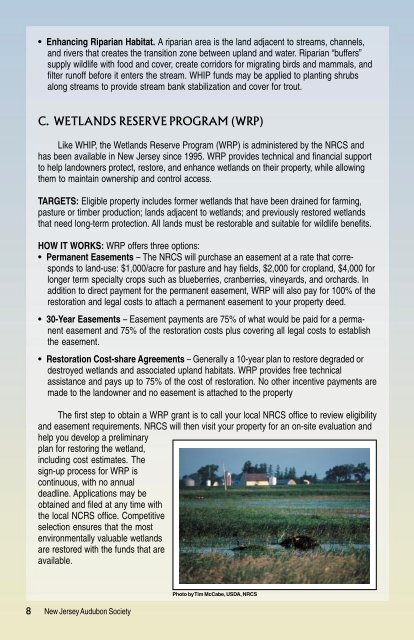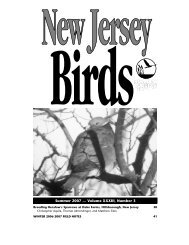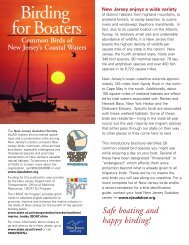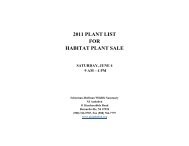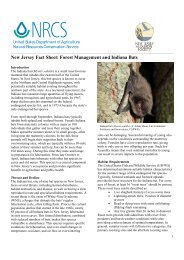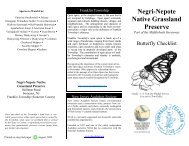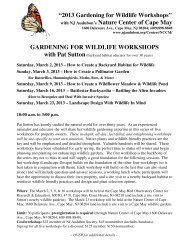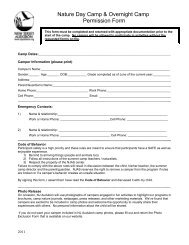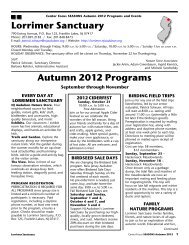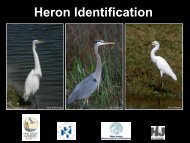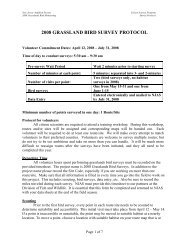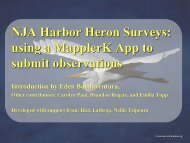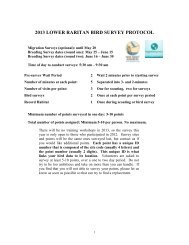Incentive Programs for NJ Landowners - New Jersey Audubon Society
Incentive Programs for NJ Landowners - New Jersey Audubon Society
Incentive Programs for NJ Landowners - New Jersey Audubon Society
Create successful ePaper yourself
Turn your PDF publications into a flip-book with our unique Google optimized e-Paper software.
• Enhancing Riparian Habitat. A riparian area is the land adjacent to streams, channels,<br />
and rivers that creates the transition zone between upland and water. Riparian “buffers”<br />
supply wildlife with food and cover, create corridors <strong>for</strong> migrating birds and mammals, and<br />
filter runoff be<strong>for</strong>e it enters the stream. WHIP funds may be applied to planting shrubs<br />
along streams to provide stream bank stabilization and cover <strong>for</strong> trout.<br />
C. WETLANDS RESERVE PROGRAM (WRP)<br />
Like WHIP, the Wetlands Reserve Program (WRP) is administered by the NRCS and<br />
has been available in <strong>New</strong> <strong>Jersey</strong> since 1995. WRP provides technical and financial support<br />
to help landowners protect, restore, and enhance wetlands on their property, while allowing<br />
them to maintain ownership and control access.<br />
TARGETS: Eligible property includes <strong>for</strong>mer wetlands that have been drained <strong>for</strong> farming,<br />
pasture or timber production; lands adjacent to wetlands; and previously restored wetlands<br />
that need long-term protection. All lands must be restorable and suitable <strong>for</strong> wildlife benefits.<br />
HOW IT WORKS: WRP offers three options:<br />
• Permanent Easements – The NRCS will purchase an easement at a rate that corresponds<br />
to land-use: $1,000/acre <strong>for</strong> pasture and hay fields, $2,000 <strong>for</strong> cropland, $4,000 <strong>for</strong><br />
longer term specialty crops such as blueberries, cranberries, vineyards, and orchards. In<br />
addition to direct payment <strong>for</strong> the permanent easement, WRP will also pay <strong>for</strong> 100% of the<br />
restoration and legal costs to attach a permanent easement to your property deed.<br />
• 30-Year Easements – Easement payments are 75% of what would be paid <strong>for</strong> a permanent<br />
easement and 75% of the restoration costs plus covering all legal costs to establish<br />
the easement.<br />
• Restoration Cost-share Agreements – Generally a 10-year plan to restore degraded or<br />
destroyed wetlands and associated upland habitats. WRP provides free technical<br />
assistance and pays up to 75% of the cost of restoration. No other incentive payments are<br />
made to the landowner and no easement is attached to the property<br />
The first step to obtain a WRP grant is to call your local NRCS office to review eligibility<br />
and easement requirements. NRCS will then visit your property <strong>for</strong> an on-site evaluation and<br />
help you develop a preliminary<br />
plan <strong>for</strong> restoring the wetland,<br />
including cost estimates. The<br />
sign-up process <strong>for</strong> WRP is<br />
continuous, with no annual<br />
deadline. Applications may be<br />
obtained and filed at any time with<br />
the local NCRS office. Competitive<br />
selection ensures that the most<br />
environmentally valuable wetlands<br />
are restored with the funds that are<br />
available.<br />
8 <strong>New</strong> <strong>Jersey</strong> <strong>Audubon</strong> <strong>Society</strong><br />
Photo by Tim McCabe, USDA, NRCS


